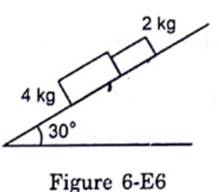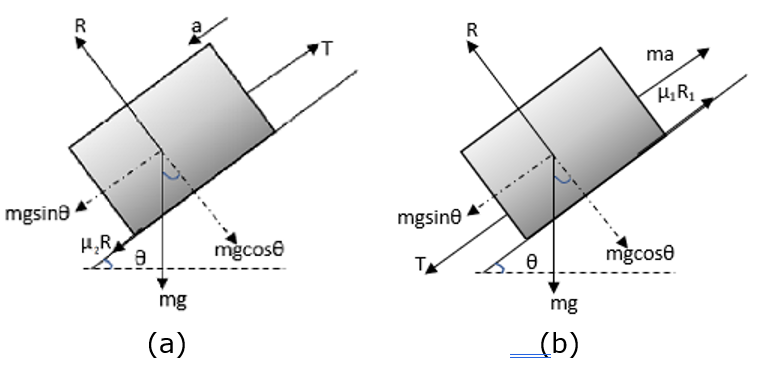Figure (6-E6) shows two blocks in contact sliding down an inclined surface of inclination 30o. The friction coefficient between the block of mass 2.0 kg and the incline is and that between the block of mass 4.0 kg and the incline is μ2. Calculate the acceleration of the 2.0 kg block if (a) μ1 = 0.20 and μ2 = 0.30, (b) μ1 = 0.30 and μ2 = 0.20. Take g = 10 m/s2.


Angle of inclination θ = 30 degree
The free body diagram of the system is shown above
From the figure (a), mass =4kg
R = 4g cos 30°
⇒ R=4×10×(![]() /2)
/2)
= 20 ![]() N (1)
N (1)
and
μ2 R + ma = T + mg sin θ
μ2 R + 4a =T + 4g sin 30°
⇒ 0.3× (40) cos 30° + 4a = T + 40 sin 30° (2)
From the figure (a), mass =2kg
R1 = 2g cos 30°
=10/![]() (3)
(3)
T + 2a − μ1R1 − 2g sin 30° = 0 (4)
From Equation (2),
6![]() +4a-T-20=0
+4a-T-20=0
From Equation (4),
T+2a+2![]() -10=0
-10=0
From equation (2) and (4)
6![]() +6a-30+2
+6a-30+2![]() =0
=0
⇒6a=30-8![]() =30-13.85=16.15
=30-13.85=16.15
⇒ a=16.15/6
=2.69=2.7 m/s2
(b) In this case, the 4 kg block will move at a higher acceleration because the coefficient of friction is less than that of the 2 kg block. Therefore, the two blocks will move separately. By drawing the free body diagram of 2 kg mass, it can be shown that a = 2.4 m/s2.